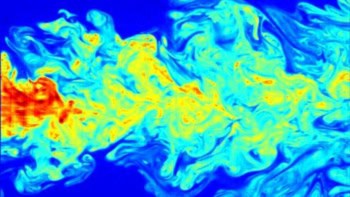
Researchers in Germany have created the first white-light data links, which they claim can transfer information at rates up to 800 Mb s–1. The team has demonstrated a simplified version of the technology in an office building, where it managed to broadcast four high-definition video streams from overhead lights.
Radio waves are very good at signalling over long distances – particularly when there are trees, buildings and other obstacles between sender and receiver. However, because radio waves are at the low-frequency end of the electromagnetic spectrum, their capacity for carrying data is limited. Furthermore, radio-frequency bands are already heavily used and highly regulated, making it difficult to find space for new services.
In contrast, visible light is much higher frequency and is entirely available to use. According to the team led by Klaus-Dieter Langer of the Heinrich Hertz Institute (HHI) in Berlin, this makes visible light an attractive option for transmitting high volumes of data over short distances. The HHI system works by encoding data by modulating the amplitude of the light. This is done 10,000 times faster than can be perceived by the human eye and therefore the team claims that the illumination system can double as room lighting.
Langer and colleagues used a white light produced by three light-emitting diodes (LEDs) – one each of red, green and blue. The researchers encoded data by varying the intensity of the light pulses from each colour. Three colour-specific photodiodes captured these signals and sent them through an oscilloscope, which digitized the signals so that they could be stored in a computer.
Record-breaking rate
In the interest of minimizing costs and maintaining the flexibility to change how the data are encoded, the data are read-out after they have been stored, rather than in real time. Even so, the red, blue and green data channels managed a combined raw data rate of 803 Mb s–1. When error correction and other protocols are implemented, the team reports that about 715 Mb s–1 remain for transferring data. Langer says this is a record-breaking rate for visible-light communications (VLC).
However, Gordon Povey, co-leader of the D-Light VLC project at the University of Edinburgh in the UK, points out that “the 800 Mb s–1 is a headline figure but it does not represent a practical scenario”. Still, he says it shows what may be possible – and that a high data rate in idealized conditions can translate to a moderate data rate in a realistic environment.
Earlier this year, Langer and colleagues began testing their system in just such a realistic setting. The team turned 16 ceiling lamps into data transmitters in a room at France Telecom’s Orange Labs in Rennes. Plain-white LEDs were used to simplify the encoding and decoding process so that a single photodiode could capture the signal. Although the set-up transmitted at a slower data rate of 100 Mb s–1, it was enough to broadcast four high-definition video streams, each about 20 Mb s–1, to the room.
Uplink is a challenge
While the team has shown that downloading data via room lighting is straightforward, uploading information would require computer-mounted LEDs, each shining towards an uplink diode. Another option would be to use a part of the electromagnetic radiation for the uplink. Next month Langer’s team will unveil a hybrid device that uses white light to send information from a webcam to a computer and infrared signals running from computer to webcam – both at a rate of 10 Mb s–1.
This type of data transfer works best in permanently lit environments, such as large office buildings, says Langer. It could also find uses in places, such as hospitals, where pervasive radio signals are unwanted. Indeed, operating theatres are often side by side, but robot-aided procedures need high-speed data transfer to send the surgeon’s orders to the robot and high-resolution images back to the surgeon. Visible-light communications could fit the bill by creating high-bandwidth links that do not disrupt data transferred at the same frequencies in the theatre next door.



